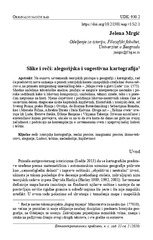| dc.description.abstract | This paper aims to present a novel approach to map analysis, treating all 'map-like' drawings as icon-texts, according to premises postulated in modem cartographical theory by Brian Harley and his successors in this field. It is not just 'deconstructing' which takes place, but further interpretations are stimulated by probing questions not only of authorship (often unknown), but also of the social, cultural, and religious environment. Making an allegorical map and text was a difficult task, an intellectual endeavor, which demanded that the author carefully choose the symbols that would outlive the material. In this paper, the Fools Cap Map of the World is presented as an example of icono-textual analysis, by bringing together the most popular literary works and their illustrations - Erasmus Desiderius, Sebastian Brandt, and Hieronymus Bosch. The double masks of the author - the pseudonym "Epichtonius Cosmopolites", with its denunciation of nationality, and the jester's costume, were chosen as the means of conveying unpleasant truths about the state of the world, France, and/ or the Netherlands. Human hybris, Suberbia and Vanitas were the primal sins, by which they were all blinded, waging wars for pieces of land and worldly goods. Therefore, the fool's malade is melancholy, strictly reserved for male intellectuals - Ficino, Diirer, Shakespeare, Bright and Burton. On the other hand, it would seem as if the female primal sin were vanity, which brings the puritan Bunyan and Anglican Thackeray into this polyphonic interpretation. Their works did, however, show that"vanitas' is present among both genders and is an everlasting human trait, now heavily exploited as a 'cash crop' par excellence. Since all knowlegde is situated, I feel the need to say that I am finishing this paper in self-quarantine due to the 'new plague' pandemic, wondering if the people in this mad and greedy world would contemplate how all is nothing, and whether the survivors would be better, i.e. more human, acting with more empathy, regardless of the perpetually announced Apocalypse. This remains to be witnessed. | en |

